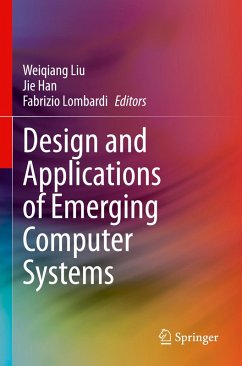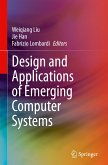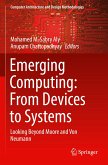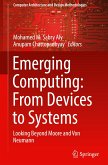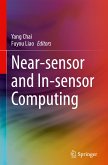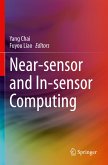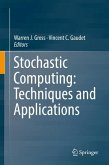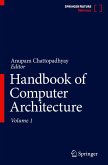Design and Applications of Emerging Computer Systems
Herausgegeben:Liu, Weiqiang; Han, Jie; Lombardi, Fabrizio
Design and Applications of Emerging Computer Systems
Herausgegeben:Liu, Weiqiang; Han, Jie; Lombardi, Fabrizio
- Broschiertes Buch
- Merkliste
- Auf die Merkliste
- Bewerten Bewerten
- Teilen
- Produkt teilen
- Produkterinnerung
- Produkterinnerung
This book provides a single-source reference to the state-of-the-art in emerging computer systems. The authors address the technological contributions and developments at various hardware levels of new systems that compute under novel operational paradigms such as stochastic, probabilistic/inexact, neuromorphic, spintronic, bio-inspired and in-memory computing. Coverage includes the entire stack, i.e., from circuit, architecture, up to system level. This book includes tutorials, reviews and surveys of current theoretical/experimental results, design methodologies and a range of applications.
Andere Kunden interessierten sich auch für
![Design and Applications of Emerging Computer Systems Design and Applications of Emerging Computer Systems]() Design and Applications of Emerging Computer Systems113,99 €
Design and Applications of Emerging Computer Systems113,99 €![Emerging Computing: From Devices to Systems Emerging Computing: From Devices to Systems]() Emerging Computing: From Devices to Systems76,99 €
Emerging Computing: From Devices to Systems76,99 €![Emerging Computing: From Devices to Systems Emerging Computing: From Devices to Systems]() Emerging Computing: From Devices to Systems106,99 €
Emerging Computing: From Devices to Systems106,99 €![Near-sensor and In-sensor Computing Near-sensor and In-sensor Computing]() Near-sensor and In-sensor Computing65,99 €
Near-sensor and In-sensor Computing65,99 €![Near-sensor and In-sensor Computing Near-sensor and In-sensor Computing]() Near-sensor and In-sensor Computing65,99 €
Near-sensor and In-sensor Computing65,99 €![Stochastic Computing: Techniques and Applications Stochastic Computing: Techniques and Applications]() Stochastic Computing: Techniques and Applications65,99 €
Stochastic Computing: Techniques and Applications65,99 €![Handbook of Computer Architecture Handbook of Computer Architecture]() Handbook of Computer Architecture458,99 €
Handbook of Computer Architecture458,99 €-
-
-
This book provides a single-source reference to the state-of-the-art in emerging computer systems. The authors address the technological contributions and developments at various hardware levels of new systems that compute under novel operational paradigms such as stochastic, probabilistic/inexact, neuromorphic, spintronic, bio-inspired and in-memory computing. Coverage includes the entire stack, i.e., from circuit, architecture, up to system level. This book includes tutorials, reviews and surveys of current theoretical/experimental results, design methodologies and a range of applications.
Produktdetails
- Produktdetails
- Verlag: Springer / Springer Nature Switzerland / Springer, Berlin
- Artikelnr. des Verlages: 978-3-031-42480-9
- Seitenzahl: 768
- Erscheinungstermin: 15. Januar 2025
- Englisch
- Abmessung: 235mm x 155mm x 41mm
- Gewicht: 1142g
- ISBN-13: 9783031424809
- ISBN-10: 3031424808
- Artikelnr.: 72824191
- Herstellerkennzeichnung
- Springer-Verlag GmbH
- Tiergartenstr. 17
- 69121 Heidelberg
- ProductSafety@springernature.com
- Verlag: Springer / Springer Nature Switzerland / Springer, Berlin
- Artikelnr. des Verlages: 978-3-031-42480-9
- Seitenzahl: 768
- Erscheinungstermin: 15. Januar 2025
- Englisch
- Abmessung: 235mm x 155mm x 41mm
- Gewicht: 1142g
- ISBN-13: 9783031424809
- ISBN-10: 3031424808
- Artikelnr.: 72824191
- Herstellerkennzeichnung
- Springer-Verlag GmbH
- Tiergartenstr. 17
- 69121 Heidelberg
- ProductSafety@springernature.com
Part-I. In-Memory Computing, Neuromorphic Computing and Machine Learning.- Chapter 1. Emerging Technologies for Memory-Centric Computing.- Chapter 2. An overview of Computation-in-Memory (CIM) architectures.- Chapter 3. Towards Spintronics Non-Volatile Computing-in-Memory Architecture.- Chapter 4. Is Neuromorphic Computing the Key to Power-Efficient Neural Networks?: A Survey.- Chapter 5. Emerging Machine Learning using Siamese and Triplet Neural Networks.- Chapter 6. An active storage system for intelligent data analysis and management.- Chapter 7. Error-Tolerant Techniques for Classifiers beyond Neural Networks for Dependable Machine Learning.- Part-II. Stochastic Computing.- Chapter 8. Efficient Random Number Source Designs Based on D Flip-Flops for Stochastic Computing.- Chapter 9. Stochastic multipliers from serial to parallel.- Chapter 10. Ising Models Based On Stochastic Computing.- Chapter 11. Stochastic and Approximate Computing for Deep Learning: A Survey.- Chapter 12. Stochastic Computing and Morphological Neural Networks: an ultra-high energy-efficient Machine Learning methodology.- Chapter 13. Characterizing Stochastic Number Generators for Accurate Stochastic Computing.- Part-III. Inexact/Approximate Computing.- Chapter 14. Automated Generation and Evaluation of Application-Oriented Approximate Arithmetic Circuits.- Chapter 15. Automatic Approximation of Computer Systems through Multi-Objective Optimization.- Chapter 16. Evaluation of the functional impact of approximate arithmetic circuits on two application examples.- Chapter 17. Energy Efficient Approximate Floating-Point FFT Design Using A Top-Down Methodology.- Chapter 18. Approximate Computing in Machine Learning Systems: Cross-level designs and methodologies.- Chapter 19. Adaptive Approximate Accelerators with Controlled Quality using Machine Learning.- Chapter 20. Design Wireless Communication Circuits and Systems Using Approximate Computing.- Chapter 21. Low-cost Logarithmic Floating-point Multipliers for Efficient Neural Network Training.- Part-IV. Quantum Computing and Other Emerging Computing.- Chapter 22. Cryogenic CMOS for quantum computing.- Chapter 23. Memristive Crossbar System towards Hardware Accelaration of Quantum Algorithms.- Chapter 24. A Review of Posit Arithmetic for Energy Efficient Computation: Methodologies, Applications, and Challenges.- Chapter 25. Designing Fault Tolerant Digital circuits in Quantum-dot Cellular Automata.- Chapter 26. CMOS Circuit-based Fully Connected Ising Machines with Parallel Updating and Its Applications in MIMO Detection .- Chapter 27. Approximate Communication in Network-on Chips for Training and Inference of Image Classification Models.
Part-I. In-Memory Computing, Neuromorphic Computing and Machine Learning.- Chapter 1. Emerging Technologies for Memory-Centric Computing.- Chapter 2. An overview of Computation-in-Memory (CIM) architectures.- Chapter 3. Towards Spintronics Non-Volatile Computing-in-Memory Architecture.- Chapter 4. Is Neuromorphic Computing the Key to Power-Efficient Neural Networks?: A Survey.- Chapter 5. Emerging Machine Learning using Siamese and Triplet Neural Networks.- Chapter 6. An active storage system for intelligent data analysis and management.- Chapter 7. Error-Tolerant Techniques for Classifiers beyond Neural Networks for Dependable Machine Learning.- Part-II. Stochastic Computing.- Chapter 8. Efficient Random Number Source Designs Based on D Flip-Flops for Stochastic Computing.- Chapter 9. Stochastic multipliers from serial to parallel.- Chapter 10. Ising Models Based On Stochastic Computing.- Chapter 11. Stochastic and Approximate Computing for Deep Learning: A Survey.- Chapter 12. Stochastic Computing and Morphological Neural Networks: an ultra-high energy-efficient Machine Learning methodology.- Chapter 13. Characterizing Stochastic Number Generators for Accurate Stochastic Computing.- Part-III. Inexact/Approximate Computing.- Chapter 14. Automated Generation and Evaluation of Application-Oriented Approximate Arithmetic Circuits.- Chapter 15. Automatic Approximation of Computer Systems through Multi-Objective Optimization.- Chapter 16. Evaluation of the functional impact of approximate arithmetic circuits on two application examples.- Chapter 17. Energy Efficient Approximate Floating-Point FFT Design Using A Top-Down Methodology.- Chapter 18. Approximate Computing in Machine Learning Systems: Cross-level designs and methodologies.- Chapter 19. Adaptive Approximate Accelerators with Controlled Quality using Machine Learning.- Chapter 20. Design Wireless Communication Circuits and Systems Using Approximate Computing.- Chapter 21. Low-cost Logarithmic Floating-point Multipliers for Efficient Neural Network Training.- Part-IV. Quantum Computing and Other Emerging Computing.- Chapter 22. Cryogenic CMOS for quantum computing.- Chapter 23. Memristive Crossbar System towards Hardware Accelaration of Quantum Algorithms.- Chapter 24. A Review of Posit Arithmetic for Energy Efficient Computation: Methodologies, Applications, and Challenges.- Chapter 25. Designing Fault Tolerant Digital circuits in Quantum-dot Cellular Automata.- Chapter 26. CMOS Circuit-based Fully Connected Ising Machines with Parallel Updating and Its Applications in MIMO Detection .- Chapter 27. Approximate Communication in Network-on Chips for Training and Inference of Image Classification Models.

